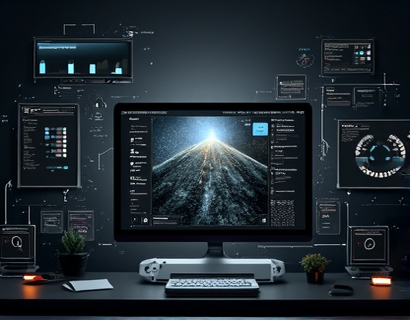Maximizing Civic Engagement: Leveraging Real-Time Data for Transparent Governance
In the digital age, the intersection of technology and governance has opened new avenues for civic engagement. Real-time data access stands as a pivotal tool in this transformation, offering unprecedented opportunities for citizens to participate in the democratic process. This article explores how real-time government data can revolutionize civic engagement through open access and transparency, enhancing accountability and fostering a collaborative government.
The Importance of Transparency in Governance
Transparency is the cornerstone of trust in any democratic system. When government operations are open and accessible, citizens can better understand and scrutinize the actions of their elected officials. This openness not only builds trust but also encourages active participation from the populace. Real-time data plays a crucial role in achieving this transparency by providing up-to-the-minute information on various government activities and decisions.
Real-Time Data: A Game Changer for Civic Engagement
Real-time data refers to information that is collected, processed, and made available to the public instantly. This immediacy allows citizens to stay informed about current events, policy changes, and government actions without delay. In a world where information is power, real-time data empowers citizens to make informed decisions and engage more effectively in civic activities.
Enhanced Access to Government Information
The availability of real-time government data significantly enhances access to information. Citizens can now monitor budget allocations, track public projects, and follow the progress of legislative initiatives in real time. This level of access was previously unimaginable, and it democratizes information that was once confined to government offices and official reports.
For instance, real-time budget data can help citizens understand how tax dollars are being spent. By accessing this information instantly, taxpayers can hold their government accountable for fiscal responsibility and transparency. Similarly, real-time updates on public projects can ensure that citizens are aware of the progress and outcomes of initiatives funded by their taxes.
Increased Accountability and Responsiveness
Real-time data not only increases transparency but also holds government officials accountable. When citizens can monitor government actions in real time, officials are more likely to act with integrity and responsiveness. The constant scrutiny from an informed public can deter misconduct and ensure that policies are implemented effectively.
Moreover, real-time data enables citizens to provide immediate feedback on government performance. Through online platforms and social media, citizens can voice their opinions and concerns, prompting officials to address issues promptly. This two-way communication fosters a more dynamic and responsive governance model.
Real-Time Government Data: Revolutionizing Civic Engagement
The integration of real-time data into governance has the potential to revolutionize civic engagement. By providing citizens with immediate access to government information, this approach breaks down barriers and creates a more inclusive and participatory democratic process.
Empowering Citizens Through Information
Informed citizens are the backbone of a healthy democracy. Real-time data empowers individuals by equipping them with the knowledge needed to engage meaningfully in civic activities. Whether it's participating in public consultations, voting in elections, or advocating for specific causes, access to timely information enhances the quality of civic participation.
For example, real-time data on environmental policies can mobilize citizens to take action on climate change. By monitoring pollution levels and government responses in real time, citizens can organize campaigns, petition for stricter regulations, and hold authorities accountable for their commitments.
Facilitating Collaborative Governance
Real-time data also facilitates a collaborative approach to governance. When government data is openly available, it encourages partnerships between citizens, non-profits, and private sectors. These collaborations can lead to innovative solutions to public challenges, leveraging the collective expertise and resources of various stakeholders.
Consider a scenario where real-time health data is made available to the public. Health organizations, researchers, and citizens can work together to analyze the data, identify trends, and develop strategies to improve public health. This collaborative approach not only enhances the effectiveness of interventions but also builds a sense of community and shared responsibility.
Challenges and Considerations
While the benefits of real-time government data are clear, there are challenges and considerations that must be addressed to ensure its successful implementation.
Data Quality and Accuracy
One of the primary challenges is ensuring the quality and accuracy of real-time data. Inaccurate or incomplete information can lead to misinformed decisions and erode trust in government. Therefore, robust data governance frameworks are essential to maintain high standards of data quality.
Regular audits, standardized data collection methods, and transparent data validation processes can help ensure that the information provided to the public is reliable and trustworthy.
Privacy and Security Concerns
Real-time data often involves sensitive information, and protecting this data from unauthorized access and misuse is crucial. Governments must implement stringent security measures to safeguard personal and confidential data.
Encryption, access controls, and compliance with data protection regulations are essential components of a secure data infrastructure. Additionally, educating citizens about data privacy and their rights can foster a culture of responsible data use.
Case Studies: Successful Implementation of Real-Time Data
Several cities and countries have successfully implemented real-time data initiatives, demonstrating the positive impact on civic engagement and governance.
Barcelona's Open Data Portal
Barcelona's Open Data Portal is a notable example of real-time data in action. The portal provides access to a wide range of city data, including transportation, environment, and public services. Citizens can use this data to monitor city operations, suggest improvements, and participate in urban planning processes.
The portal has not only increased transparency but also fostered innovation. Developers and citizens have created numerous applications and tools that leverage the open data, enhancing the quality of life in the city.
Estonia's Digital Government
Estonia is often cited as a leader in digital governance. The country's e-Government platform offers real-time access to a multitude of services, from voting to tax filing. This digital infrastructure has significantly improved civic engagement by making government services more accessible and user-friendly.
The real-time data feature of the platform allows citizens to track the status of their applications, monitor public spending, and engage in online consultations. This level of digital engagement has set a global standard for transparent and efficient governance.
Moving Forward: Building a More Transparent and Participatory Governance Model
The potential of real-time data to transform civic engagement and governance is immense. To fully realize this potential, several steps must be taken by governments, citizens, and technology providers.
Government Commitment
Governments must commit to transparency and open data initiatives. This commitment should be reflected in policies and practices that prioritize data openness and citizen access. Establishing dedicated agencies or departments focused on data governance can help ensure consistent and high-quality data delivery.
Moreover, governments should actively seek feedback from citizens to improve data offerings and address any concerns related to privacy and security.
Citizen Engagement
Citizens play a vital role in the success of real-time data initiatives. Active participation in monitoring government data, providing feedback, and using data to drive civic actions is essential. Educational programs and workshops can help citizens understand the value of real-time data and equip them with the skills to utilize it effectively.
Online platforms and social media can serve as powerful tools for citizen engagement, facilitating discussions, and mobilizing collective action based on real-time information.
Technological Innovation
Technology providers have a crucial role in developing tools and platforms that make real-time government data accessible and usable. User-friendly interfaces, data visualization tools, and mobile applications can enhance the accessibility of data for a broader audience.
Collaboration between governments and tech companies can lead to innovative solutions that address specific civic needs, such as real-time crime reporting or traffic management systems.
Conclusion
The integration of real-time data into governance represents a significant step towards a more transparent, accountable, and participatory democratic system. By providing citizens with immediate access to government information, real-time data empowers individuals to engage more deeply in civic activities and hold authorities accountable.
As more cities and countries adopt real-time data initiatives, the potential for positive change grows. It is a movement that requires the collective effort of governments, citizens, and technology providers. Together, we can build a future where governance is not just transparent but also collaborative and responsive to the needs of the people.










































